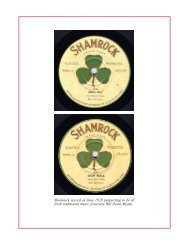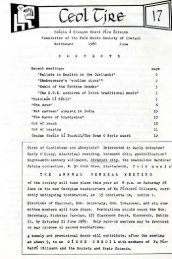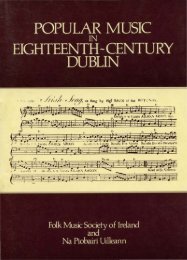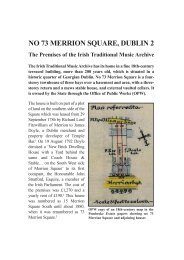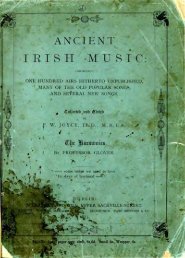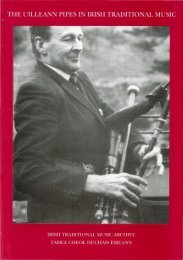Union Pipes - Irish Traditional Music Archive
Union Pipes - Irish Traditional Music Archive
Union Pipes - Irish Traditional Music Archive
You also want an ePaper? Increase the reach of your titles
YUMPU automatically turns print PDFs into web optimized ePapers that Google loves.
COURTNEY’S ‘UNION PIPES’ AND THE TERMINOLOGY OF IRISH BELLOWS-BLOWN BAGPIPES 74<br />
‘New Improved <strong>Irish</strong> <strong>Pipes</strong>’; 254 but by 1812 after he has moved to<br />
Dublin he is advertising ‘Grand <strong>Union</strong> <strong>Pipes</strong>’ for ‘the lovers of that<br />
ancient National Instrument’. 255 The professional Limerick piper<br />
Patrick O’Connor was advertised as playing these ‘Grand <strong>Union</strong><br />
pipes’ by 1816; 256 and the Wexford piper S.T. Colclough was calling<br />
himself ‘Professor of the Grand <strong>Union</strong> <strong>Pipes</strong>’ by about the same<br />
period. 257 Edward Plunket is playing in Dublin on the ‘National<br />
<strong>Union</strong> <strong>Pipes</strong>’ in 1814. 258 In 1823 the professional William Talbot is<br />
playing on the ‘improved <strong>Union</strong> Pipe’, 259 which is likely to be also<br />
Kenna’s instrument. 260 On the other hand Patrick O’Connor’s only<br />
pupil, Griffin of Limerick, describes his instrument in 1819 and<br />
again in 1841 as the ‘Chromatic Organ <strong>Pipes</strong>; being an improvement<br />
on the construction of the ancient <strong>Irish</strong> pipes’. 261 A Dublin <strong>Irish</strong>-<br />
English dictionary of 1817 262 refers to the ‘píobshionnaich, a pipe<br />
blown with bellows’ (which is further developed by a Scottish<br />
dictionary of 1911 as ‘pìob-shionnaich, <strong>Irish</strong> bagpipe’, deriving it<br />
254<br />
Dublin Evening Post, Dublin, 12 Aug. 1802.<br />
255<br />
Freeman’s Journal and Daily Commercial Advertiser, 23 March 1812<br />
(reference courtesy Seán Donnelly). A Scottish piper Arbuckle (see Note 199<br />
above) was using the term earlier, but no connection with Kenna is apparent and<br />
the two may have coined the term independently.<br />
256<br />
Donnelly 1994b: 81.<br />
257<br />
Colclough c 1815: title page.<br />
258<br />
Freeman’s Journal, Dublin, 30 July 1814 (reference courtesy Seán Donnelly).<br />
259<br />
‘Pub. Augt. 1823, at the Artists Depository, 21 Charlotte St., Fitzroy Sq.’<br />
– print, reproduced in An Píobaire vol. 7, no 4 (Sept. 2011): 22.<br />
260<br />
‘There was some years ago, playing in the taverns of Dublin, a blind piper<br />
named Talbot... His own pipes, which he called the “grand pipes”...’ –<br />
William Carleton, Tales and Sketches, Illustrating the Character, Usages,<br />
Traditions, Sports and Pastimes of the <strong>Irish</strong> Peasant, James Duffy, Dublin,<br />
1845, quoted in An Píobaire vol. 7, no 4 (Sept. 2011): 23–4<br />
261<br />
Donnelly 1994b: 94; Manchester Guardian, Manchester, 10 Nov. 1841.<br />
262<br />
O’Reilly 1817: ‘píobshionnaich’ [no pagination]. The term is also found in<br />
O’Reilly’s ‘new edition’ of 1821, and in Armstrong 1825, a Scots Gaelic<br />
dictionary.



